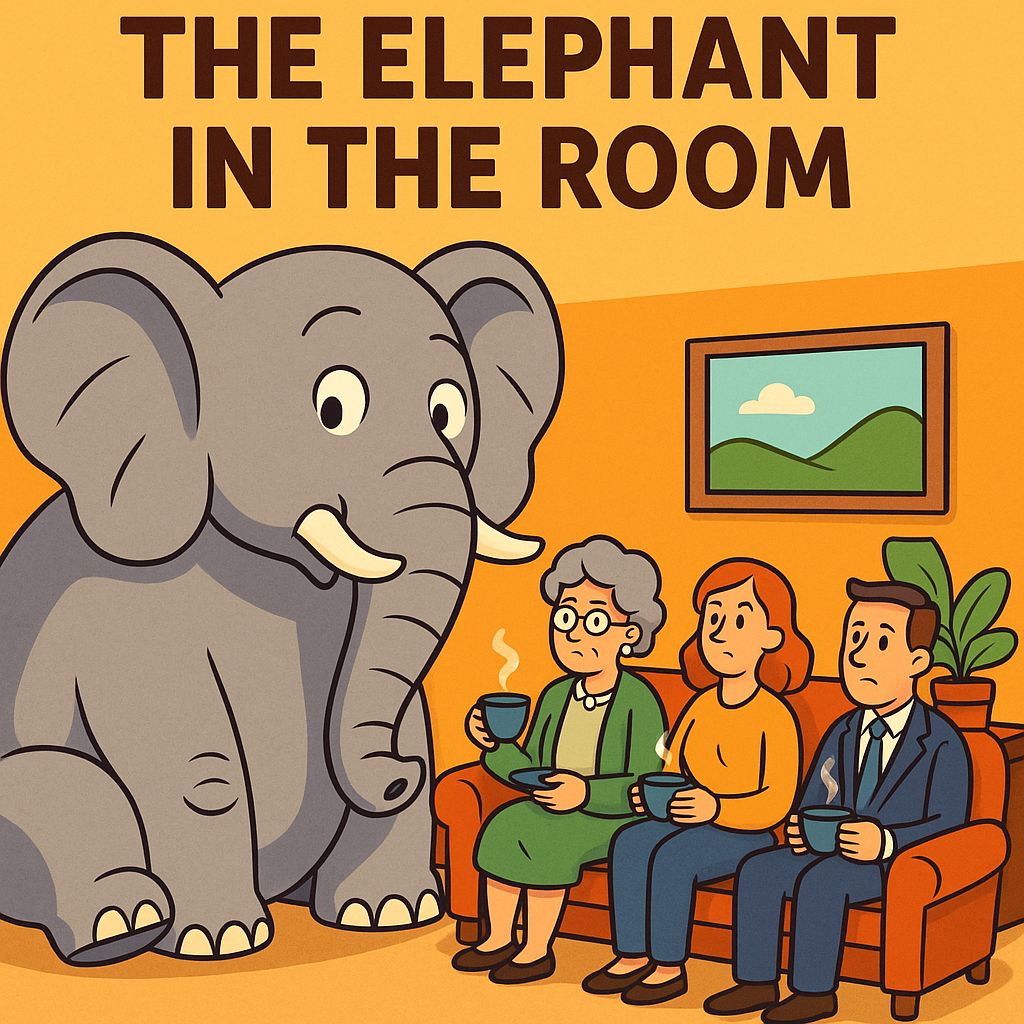We’ve all been there: sitting in a meeting, a committee discussion, even a family gathering — and there it is. A huge, obvious issue nobody wants to mention. Everyone feels it, everyone knows it’s there, but lips stay sealed. That’s the “elephant in the room.”
It’s one of those phrases we toss around so easily, but its origins are more curious than you might expect.
Where the phrase comes from
The metaphor of an elephant — large, impossible to ignore — has floated around European writing for centuries. The earliest recorded use in English dates back to the early 19th century, when poet Ivan Krylov’s fable The Inquisitive Man was translated from Russian.
In Krylov’s tale, a man walks through a museum and notices every small detail — but completely misses the elephant on display. The fable was meant as a satirical jab at scholars who obsess over minutiae while ignoring obvious truths.
By the late 1800s, English writers were using “elephant in the room” to describe not just blindness but deliberate avoidance. A problem so glaring that silence around it becomes awkward, even absurd.
How it became popular
The phrase caught on during the 20th century, particularly in American business and political speech. Journalists loved it because it painted such a vivid picture: an unspoken crisis looming large while everyone pretends nothing is wrong.
By the 1980s and 90s, “the elephant in the room” was a boardroom cliché. It remains so today — though still powerful, because it gives instant weight to the idea of wilful silence.
Elephants in my own rooms
I’ve encountered a few “elephants” myself.
-
In cricket: captaining school sides, the elephant might be an underperforming opener everyone hoped would “come good.” Nobody wanted to drop him, but his form weighed heavily on results.
-
In dentistry: in professional meetings, the elephant often loomed as money versus care — how to balance NHS funding pressures with patients’ real needs. Everyone tiptoed around it.
-
In online marketing: the elephant for beginners is usually traffic. We buy tools, design banners, write posts — but unless traffic flows, none of it matters. Yet many avoid talking about it because it feels uncomfortable to admit.
The elephant is always the same: an issue so large that ignoring it becomes a form of silent agreement.
Why the metaphor works
The beauty of “elephant in the room” lies in its universality.
-
Size: elephants are massive; the metaphor conveys undeniable presence.
-
Silence: unlike lions or tigers, elephants aren’t predators. Their threat in the metaphor is passive — the absurdity of pretending they’re not there.
-
Absurdity: the idea of cramming an elephant into a room instantly jars the imagination.
It’s a phrase that mixes humour with seriousness, which is why it works across politics, business, sport, and even family life.
Close cousins of the phrase
Other idioms echo the same theme:
-
“The 800-pound gorilla” — not about silence but dominance; a force too powerful to oppose.
-
“White elephant” — something large and burdensome, often a costly but useless possession.
-
“The skeleton in the cupboard” — a hidden shame, though here the focus is secrecy, not obviousness.
Each has its place, but the elephant in the room remains king of the idiomatic jungle when it comes to obvious but unspoken problems.
Lessons for life and business
So what do we do about elephants?
-
Name them early. Pretending issues don’t exist rarely helps. Naming the elephant often relieves tension in the room.
-
Tackle them directly. Problems don’t shrink by being ignored; they usually grow fatter and heavier.
-
Don’t be the oblivious scholar. Krylov’s original lesson still applies: don’t get so lost in details that you miss the glaring truth.
In affiliate marketing, that elephant is often the lack of focus. We chase shiny objects, fiddle with design, or pretend a dozen half-started projects equals progress. Better to point at the elephant and deal with it: you only need one working system at a time.
Final thought
The next time you’re in a meeting, a Zoom call, or even a WhatsApp group, ask yourself: is there an elephant here? If so, the bravest move might be to gently point at it. You’ll be surprised how many others are relieved when someone finally does.



